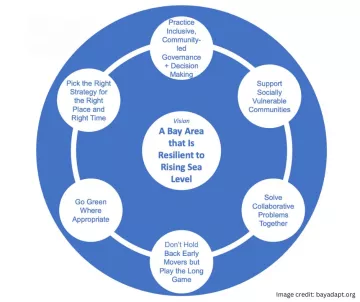What is happening

A new State law took effect in January 2024 that requires all shoreline jurisdictions in California to create and gain approval for Sea Level Rise Adaptation Plans no later than January 1, 2034. Known as SB272 or the “Laird Bill,” the legislation tasked the Bay Conservation and Development Commission (BCDC) with responsibility for developing a Regional Shoreline Adaptation Plan (RSAP), including guidelines designed to coordinate planning strategies among Bay shoreline communities.
Importantly, the law also gave BCDC authority to approve or deny sub-regional plans. This new approval authority represents the first regional governance and enforcement mechanism brought to bear to make sure all of our communities are actively preparing for sea level rise, using the best available science. (The California Coastal Commission was given similar responsibility and authority on the coastal side of the state.)
BCDC must develop and adopt the Guidelines by the end of this year and they are expected to include consistent standards and minimum criteria appropriate to each sub-region.
Why it Matters
Sea level rise threatens to bring widespread damage to shoreline property, built and natural infrastructure, and public health, with disproportionate impacts on communities with the least resources and capacity to adapt. SB272 and the RSAP create an unprecedented opportunity to ensure that our region plans for sea level rise in a visionary, equitable, and coordinated way.
By speaking up throughout the planning process, you can help make sure that BCDC’s RSAP Guidelines make the most of the resiliency tools nature provides, reduce disproportionate burdens on marginalized populations, and define adaptive pathways for people, industry, infrastructure and nature as the sea level rise threat evolves.
Every Bay shoreline community will have to follow whatever guidelines BCDC adopts, so the outcome of this year’s planning process will be felt Bay-wide with impacts for decades to come. BCDC is working hard to make sure its outreach and planning process is inclusive and comprehensive, but one year is a very short time for a planning project of this magnitude, so things are moving fast.
Bay Alive Priorities
- Put Nature First - Prioritize restoration, land use protection, and nature based strategies to capitalize on nature’s essential biodiversity and resilience tools, creating sustainable, and often more affordable, solutions that can naturally evolve over time to changing conditions.
- Level the Playing Field - Advance environmental justice by prioritizing strategies to reduce disproportionate impacts from sea level rise in communities with the least capacity to adapt. Efforts to mitigate existing risks and prevent future harm in such communities should include region-wide and inter-agency commitment and investment.
- Create Adaptive Resilience Pathways - Plan for phased adaptation pathways to address uncertainty in future sea level rise projections, allowing for flexibility and potentially spreading the costs over time.
Urgent and Unprecedented Opportunity to Protect Our Communities and Preserve Our Healthy, Living Bay
Learn more about the Regional Shoreline Adaptation Plan.